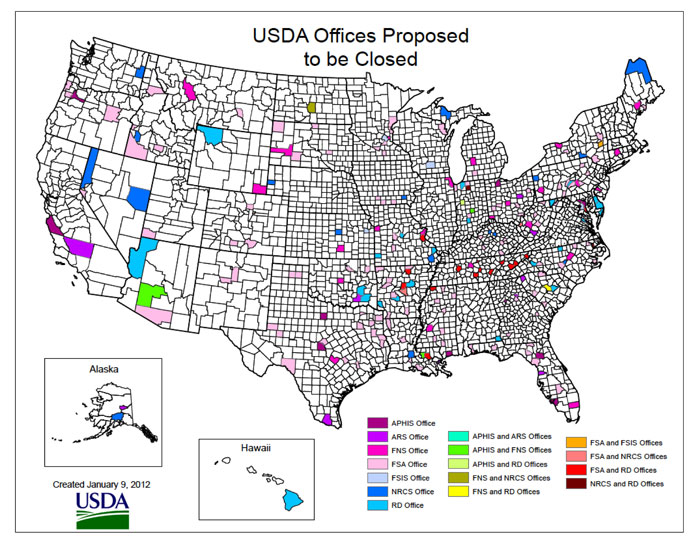January 10, 2012

Facing a shrinking budget, Agriculture Secretary Tom Vilsack has outlined moves – including the closure of 259 offices, facilities and labs under the USDA umbrella – to save some $150 million annually. Some of the closings have been announced previously.
The shuttering of the USDA offices, made under a plan titled “A Blueprint for Stronger Service,” was unveiled during a Monday speech that Vilsack delivered at the American Farm Bureau Federation’s ninety-third annual meeting. He told the assembly that since 2010, Congress has reduced USDA discretionary spending by nearly 12 percent, or more than $3 billion.
For the USDA plan, see here. http://usda.gov/wps/portal/usda/usdahome?contentidonly=true&contentid=blueprint_for_stronger_service.html
A map showing where USDA offices will be closed can be seen here. http://usda.gov/wps/portal/usda/usdahome?contentidonly=true&contentid=impacted_offices.html
As a result, “some agencies were reduced more than others. Agencies facing steep cuts, specifically in their salaries and expense line item that fund personnel, included the Farm Service Agency, Rural Development, the Animal and Plant Health Inspection Service, the Agricultural Research Service and the Food and Nutrition Service.”
To read Vilsack’s prepared AFBF remarks, see here. http://content.govdelivery.com/bulletins/gd/USDAOC-2517ea
In a Monday blog post (see here http://blogs.usda.gov/2012/01/09/a-blueprint-for-stronger-service/), Vilsack pointed to measures already taken in some USDA offices including hiring controls and early separation programs. “These efforts, when coupled with regular retirement, meant nearly 7,000 employees have retired from USDA over the past 15 months.”
Further, the “A Blueprint for Stronger Service" details a list of 133 recommendations that affirm processes already in place, as well as 27 initial improvements, and others aimed at longer-term improvements. The initial recommendations include the following:
Consolidate more than 700 cell phone plans into about 10.
Standardize civil rights training and purchases of cyber security products.
Ensure more efficient and effective service to our employees by moving toward more centralized civil rights, human resource, procurement, and property management functions, creating millions of dollars in efficiencies without sacrificing the quality of our work.”
Vilsack told the AFBF that shedding 7,000 USDA employees “allowed us the flexibility to eliminate positions or restructure positions to be more relevant to the needs of our customers. Many of the positions we will fill will be at pay rates less than before. Given the reduced resources, our other choice of further reductions in force or furloughs would be very disruptive to the services that matter to you and those in rural America.”
While Vilsack said the workforce reductions were necessary, he acknowledged they come at a time “when more work was being demanded of our staff. For example, new programs called for by the 2008 farm bill. FSA, with a reduced workforce had to institute new disaster programs like SURE and the Livestock Forage and Indemnity programs. At the same time, Rural Development and FSA were beginning to implement the new Energy Title programs. Workloads were also increased in the area of nutrition assistance as a result of the recession and expanded need to help struggling families manage.”
Vilsack addressed the closing of 131 FSA offices specifically. “First, in making the decision to close an office, FSA relied on the 2008 farm bill criteria for determining what offices would be considered. Of the 131 offices on the list, 35 currently have no employees — the balance of the offices have either one or two employees and are within 20 miles of another FSA office. The work of these offices will be assigned to the adjoining county office, and personnel given the opportunity to transfer as well.”
The FSA office closings will begin immediately with an aim to finish the process by July. “All the other agencies … aim to close facilities by the end of September. I know that some may be inconvenienced by this choice, but services will not be interrupted.”
Vilsack later told reporters he did not “anticipate a significant amount of pushback” to the planned closures “once folks are shown the numbers. … It’s a little different context than in the past (due to a) year-plus of talk about the need to get our fiscal house in order.”
For more, see here and here.
You May Also Like




